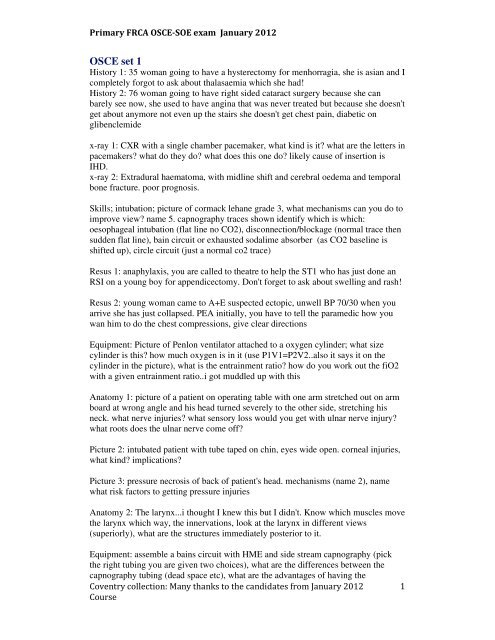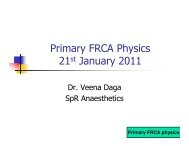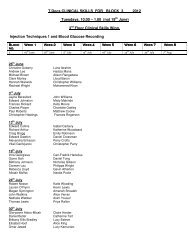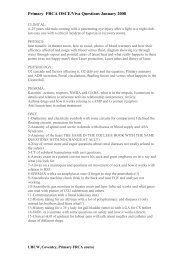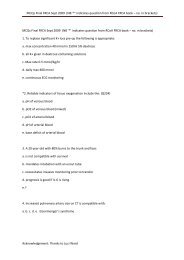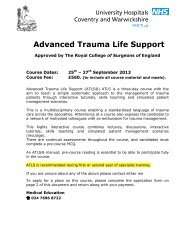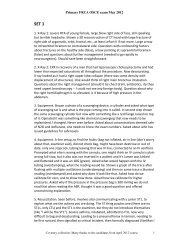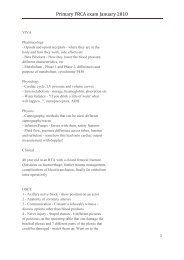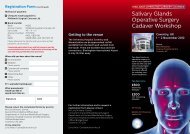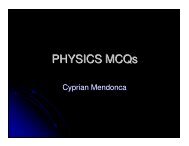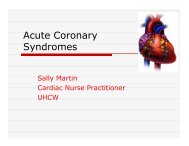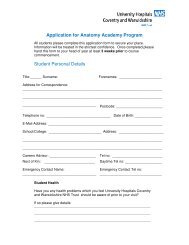Primary FRCA OSCE January 2012
Primary FRCA OSCE January 2012
Primary FRCA OSCE January 2012
- No tags were found...
Create successful ePaper yourself
Turn your PDF publications into a flip-book with our unique Google optimized e-Paper software.
<strong>Primary</strong> <strong>FRCA</strong> <strong>OSCE</strong>-SOE exam <strong>January</strong> <strong>2012</strong>capnography at the patient end? what are the disadvantages?Communication: Jehovah's witness going to have abdo hysterectomy next week formenhorragia and she has an Hb of 7.2. She refuses to have any blood transfusions.ECG: You are called to see a patient in recovery who is confused post-op.Bradycardia rhythm strip 40bpm. Management.Anatomy 3: cross section of spinal cord: different ascending tracts, tell me about thepain pathway after a pin prick to the finger?Skills: Epidural. How much local to block each segment. how to perform, structuresthat you pass through. complications.<strong>OSCE</strong> set 21. CXR - large thyroid mass.2. CXR - pulmonary oedema3. Simulation - tension pneumothorax, demonstrate on manikin how to decompress.Describe chest drain insertion. Other differentials.4. Intraosseous needle. Demonstrate on dummy. Exact questions as Coventry course.5. History-taking - elderly man for hemicolectomy. Hx MI, AF (failed cardio versionon warfarin), arthritis. I think main issue was cardiac history.6. O2 measurement - 3 diagrams (Clark electrode, fuel cell, paramagnetic analyser).Asked to indicate which was Clark. Name electrodes & electrolyte. Given list ofequations - which one takes place in Clark. Name other 2 diagrams. What else canClark electrode be used for (not sure what he wanted, he kept saying I had said it inmy previous answer but I had no clue what I'd just said!)7. Spinal cord anatomy - had ascending tracts drawn on right side (unlike mosttextbooks which have them on left) which threw me off initially. Name gracilis &cuneatus. Function. Which tract involved in pain & temperature, point out ondiagram. What is grey matter, what does it contain. Blood supply of spinal cord. Whatis spinal artery syndrome. Specific gravity of CSF. Volume of CSF.8. Equipment - shown epidural kit. Asked if I would be happy to use it. Had a hole init, said no. Gave me an open pack and asked to check it. Asked to demonstrate how Iwould check it (I attached filter to catheter, pretended to flush it etc). Asked if I washappy to use it, said yes but he just snarled. He was not a happy examiner (agreed byall candidates I spoke to!). Filter pore size, function.9. Obstetric resus. Scenario was CT1 had just inserted epidural, now patient isunconscious. Resus officer as your assistant. Wedge. Non-shockable rhythm bothCoventry collection: Many thanks to the candidates from <strong>January</strong> <strong>2012</strong>Course2
<strong>Primary</strong> <strong>FRCA</strong> <strong>OSCE</strong>-SOE exam <strong>January</strong> <strong>2012</strong>times. Asked dose of adrenaline. Asked to demonstrate intubation when I said I wouldintubate (Grade 1 no worries). Differentials (total spinal, AFE, etc). What if continuedresus unsuccessful (C-section within 5 minutes). How to treat total spinal (I saidsupportive treatment etc, but she kept asking for more, not sure what else she wasexpecting). What symptoms/signs of high spinal.10. Cranial nerves. Trigeminal nerve - how many nuclei, where are they situated.What branches. Where does V1, V2, V3 exit and point on skull. What do theyinnervate. What about motor component of V3. How do you test facial nerve. Whatelse does facial nerve innervate (I said taste for ant 2/3 tongue, chorda tympani, but hewanted more). Which nerve innervates posterior 1/3 of tongue (IX).11. History taking. Lady due for some hand surgery. Bad arthritis affecting lung,kidneys. On Methotrexate & Prednisolone. Lots to ask re. various systems affected.12. Electrical safety. Shown diagram of patient on operating table which was earthed.Connected to ECG, which was earthed. Also connected to ?arterial line which wasearthed. Asked re. microshock, and various questions about earth and equipotentialstuff which I had no idea about. Then shown a bunch of pictures of various electricalsymbols. Pick 2 and tell me what they represent. Bad station, most candidates I spoketo had no idea what was going on.13. Capnography. Shown picture of capnograph, what 3 parameters can be derivedfrom this (etCO2, fiCO2, rate). Principle of capnography. What do different phasesrepresent. What if there's upward slope of plateau. Name 3 critical incidents that acapnograph can show.14. Communication skills. Ex-IVDU for appendicectomy. On methadone, concernedre. pain relief and relapse if given morphine. Very short station, gave a lot ofreassurance and found had a lot of time left. I went into history etc. to kill time, wasstopped by examiner who said it was not necessary.15. Shown ECG of fast AF (looked regular but only after drawing those lines onblank piece of paper found that it was not). Name one investigation that will help youdetermine cause. What energy levels and how many shocks will you deliver forDCCV. Contraindications for DCCV. Name drugs to slow rate. How is amiodaronegiven. How else will you manage this patient if he was stable but not responding tochemical cardioversion.16. Questions re. difficult airway. Shown diagram of Grade 3 laryngoscopy - what isit (wanted Grade 3 Cormack-Lehane). What would you do now. Still can't intubate,next step. Now can't ventilate, LMA. Can't ventilate via LMA. Describe differenttechniques of crico (needle vs surgical). Jet ventilator, how do you use it.<strong>OSCE</strong> set 31) Simulation Station: CT1 just intubated young male with life-threatening acuteasthma, so far given nebulised salbutamol & iv steroids. You as SpR called by CT1for help as pt starts desaturating, tachycardic. DD: tension pneumothorax. Asked toactually do needle thoracocentesis on SimMan, then describe chest drain insertion.Coventry collection: Many thanks to the candidates from <strong>January</strong> <strong>2012</strong>Course3
<strong>Primary</strong> <strong>FRCA</strong> <strong>OSCE</strong>-SOE exam <strong>January</strong> <strong>2012</strong>2) Intraosseous needle insertion - indications, sites, demonstrate on mannikin,complications, etc3) Hx-taking: 70ish yo male for elective hemicolectomy. Hb 7.0. PMH: IHD,previous MI. On further questioning, started telling me about previous angiogram,failed pace-maker insertion, chronic AF, also currently on some 'blue' tablet, onlyconfirmed it warfarin when I suggested to him.4) Diagrams & questions on 02 measurement: paramagnetic, fuel cell, polarographic5) Transverse section of spinal cord: describe ascending & descending tracts, bloodsupply, anterior spinal artery syndrome6) Epidural kit: components, whether would use set given (I said no as there was atear at the plastic covering), then asked to check epidural set (?possibly assemble),function of filter, size of filter material, why saline is preferable for LOR compared toair, state major complications of epidural (started off with PDPH, examiner didn'tlook too happy, he reiterated 'MAJOR complications' of epidural insertion, so talkedabout nerve damage/paraplegia, haematoma, high block/total spinal). Should've beenstraightforward but examiner looked unhappy throughout.7) DAS guidelines of difficult intubation, CICV.8) Simulation Station: 38/40 pregnant lady just had epidural inserted, on injection ofLA, started feeling drowsy & began losing consciousness. Assess & manage. Call forhelp, o2. Pt eventually went into cardiac arrest, asystole & non-shockable algorithm.No help but paramedic who didn't do chest compressions correctly so had to quicklyshow. Intubated mannikin. Then long list of questions on total spinal.9) ECG rhythm strip. Irregular narrow complex tachycardia - fast AF. Asked for otherdifferentials. List signs of instability; if so, what would you do? If pt is stable, howwould you manage? How would you rate control? When would you not use DCcardioversion? (initially confusing, but all he wanted was post-48hrs after onset)Energy of DC cardioversion (biphasic/monophasic). Dose of amiodarone used.10) Communication. 20-yo lady previous IVDU, currently on methadone, in forappendicectomy, very concerned about pain issues & use of morphine post-op.Ascertain her concerns & reassure her.11) Hx-taking. 80-ish yo female for elective hand procedure. Hx of RA, previous TB& right pneumonectomy (only mentioned when asked about previous ops). Couldn'tremember her medications, but will produce prescription list when asked (onprednisolone 60mg!)(also on various others inc methotrexate).12) Anatomy of basal skull.13) Radiology: CXR of lady booked for thyroidectomy. Huge retrosternal goitre seenwith tracheal deviation. Would you anticipate difficult intubation? etcCoventry collection: Many thanks to the candidates from <strong>January</strong> <strong>2012</strong>Course4
<strong>Primary</strong> <strong>FRCA</strong> <strong>OSCE</strong>-SOE exam <strong>January</strong> <strong>2012</strong>14) Radiology: CXR of male admitted with SOB. Looked like atypical pneumonia,with bilateral shadowing, with questions whether you would use macrolide to treat pt,whether CCF is a possibility, etc.15) Electrical safety: very confusing station. Given different diagrams of electricalsymbols, supposed to describe each. Also questions on micro shock.<strong>OSCE</strong> set 41. History taking: Elderly + DM + IHD for cataract2. History taking : Asian lady with dry cough, night sweats and Hb: 7.2 forhysterectomy (thalassemic)3. Communication : Jehovah’s witness for hysterectomy4. Bains circuit: was asked to assemble with filter and EtCO2 tubing. There wasan additional IV set extension tubing kept and was asked why it cant be usedfor capnography. Then was shown three capnography traces a)rebreathing b)Disconnection c) Blocked tube5. Clinical Skills: Insertion of lumbar epidural. Was asked to demonstrate on theactor how to locate correct spaces. Very detailed step by step description ofthe procedure was required.6. Oxygen CD cylinder with transport ventilator. a) Identify the equipment b).What is the volume of CD cylinder c) Uses d) This was followed by 3questions on calculations7. Larynx anatomy: shown a lateral cross section and identify various labelledstructures. Sensory and motor nerve supply. Abductors and adductors of cords.Elevators and depressors of larynx.8. Anatomy of spine question in the college guide, word to word9. Carbon dioxide measurement question from college guide, again word toword.10. Examination of a trauma patient with triage. Then went on to management ofpneumothorax11. Safety: Photo of a patient with hyperabducted arm. Which nerve likely to bedamaged. Nerve roots. If damaged, which part of the hand affected . Anotherphoto with a patient under GA with open eyes. What harm caused to eyes.How will you prevent.12. Photo of grade 3 Cormack Lehan view . How will you improve. Threemethods to identify esophageal intubation.Coventry collection: Many thanks to the candidates from <strong>January</strong> <strong>2012</strong>Course5
<strong>Primary</strong> <strong>FRCA</strong> <strong>OSCE</strong>-SOE exam <strong>January</strong> <strong>2012</strong>13. Xray of pacemaker: a) whether it is DDD type b) Does it have defib functionc) 4th letter denotes defib function d) a magnet will be required intraop e)pacemaker was inserted secondary to IHD f) question relating to safe use ofdiathermy.14. CT head of a patient with RTA a) there is air in Left frontal sinus b) Is it LeftEDH c) There is fracture of temporal bone on right d) There is evidence ofmidline shift e) He requires intubation on admission f) prognosis very poor athis age g) urgent evacuation needed15. Simulator: Anaphylaxis following RSI and cefuroxime16. Rest two don’t remember. One was a postop patient in ward with bradycardia.I was shown an ecg and asked several questions.<strong>OSCE</strong> set 51. CXR of coarction of aorta2. Xray neck for ankylosing spondylitis3. Simuation of light plane of Anaesthesia4. Caudal block with sacral bone for landmarks5. Methods of measuring humidity and applications6. Cross section of C6 level7. Anaesthetic instrument: iv giving sets with 2 drip chambers and a white ball in the2 nd chamber8. Anatomy of trigeminal nerve9. Simulation: VT with demonstration of DC cardioversion10. Anaesthetic instrument: precordial stethoscope11. simulation: cardiac arrest in the ward12. history taking station: lady for lap surgery with family history of malignanthyperthermia13. history taking station: 36 weeks pregnant lady for epidural analgesia withpervious failed intubationcommunication: talk with relative for her father admitted for AAA rupture and repair<strong>OSCE</strong> set 61.spinal section and anatomy (rcoa guide)2. History station3. Epidural set :?can u use , filter ,4. O2 analysers : fuel cell, Clarke, paramagnetic , with photos5, failed intubation drill6 pregnant lady had epidural dose now unresponsive ; cardiac arrest .,, I saw pea ?Others had vf and ? Shocked,Coventry collection: Many thanks to the candidates from <strong>January</strong> <strong>2012</strong>Course6
<strong>Primary</strong> <strong>FRCA</strong> <strong>OSCE</strong>-SOE exam <strong>January</strong> <strong>2012</strong>7. Communication ;pt on methadone concerned about pain relief after surgery8. Af : ECG and discussion9 . Cxr. : tubular heart , upper lobe blood diversion. Some one with 2 mth.h/o sob10. X-ray neck and upper chest : patient with thyroid nodule and on propronalol ;tracheal deviation , iv access in foot.11. Cvs examination12.sim man , asthmatic patient intubated ventilated : airway pressure high, tracheadeviated , I treated as pneumothorax13.history for arthritis patient coming for jt surgery of hand , had RA14. Intraosseous needle insertion15. Electrical safety (toughest ) earthing how to reduce etc, identify 2 symbols , wt ifone of the ECG electrode is mis connected16. Capnography and various traces : didn't go very well17: Base of skull and asked about tri geminal and facial18 rest station<strong>OSCE</strong> set 7Anatomy of spinal cord, hemisection and anterior cord syndromeAnatomy of diaphragm- nerve supply muscles of respiration, attachments andopenings.Electrical symbols, microshock and earthPca lineMono auricular stethoscopeRotametersCheck equipment for RSI- lots of blockages and leaking cuff, asked what elserequiredECG strip asystoleXray coartation aortaSim shockable resusSim dislodged trache, difficult intubation, laryngoscopes had no bulb no needle cricor quick trache, cicv.Resp examComm - anaesthetic options for c sectionHistory- Elective TAH previous awareness and post op PE. AnaemicHistory- elective THR. Arthritis, cardiac hx murmur, oedema PND orthopnoeaExplain needle thoracocentesis and formal chest drain<strong>OSCE</strong> set 8lots of resus algorithms, difficult airway management - at least four stations on thistwo histories seemed straight forward, actors very forthcomingcomm station tough - had to discuss option for elective csection; didn't really come toany conclusion, ran out of time and wasn't sure what they wantedanatomy: diaphragmantomy: spinal cord cross section, tractsCoventry collection: Many thanks to the candidates from <strong>January</strong> <strong>2012</strong>Course7
<strong>Primary</strong> <strong>FRCA</strong> <strong>OSCE</strong>-SOE exam <strong>January</strong> <strong>2012</strong>CXR: coarct aorta (i think, by the q's asked, but have to admit the rib notching wasnot entirely obvious to me)CXR: mitral regurg, cardiomegaly etctension pneumothorax recognition and managementexamine resp system and inerpret spirometrymonaural stehtoscopeelec safety q with diagram which i just didn't understand.check equipment for rsi<strong>OSCE</strong> set 91. DAS guidelines on failed intubation. Shown a picture of Gd 3 Cormack & Lehane– how can I improve view, what equipment I want. Then moved through steps forfailed intubation in RSI2. Resuscitation – pregnant lady epidural top up for cat 1 delivery – PEA,management of arrest – if you gave adrenaline as soon as you noticed it was aPEA, the following cycle she has a pulse (if you didn’t give adrenaline, thescenario went on until you did)3. Anatomy – trigeminal and facial nerves. Which foramen the ophth & mandibularbranches emerge from. What they supply. Facial nerve, what it supplies and howyou test.4. Communication – pt for appendicectomy on methadone – worried about painespecially about relapse if has morphine5. Electrical safety – shown a diagram of equipment with different earthconnections, asked how microshock is prevented in this diagram, what are thepotential differences of the earth wires. Shown a sheet of about 15-20 symbols,pick 2 and state what they mean (most of them were not ones I have seenanywhere)! – Hoping this was a test station – everyone found it ridiculously hard!6. History – pt with RA, on steroids and methotrexate, PONV, poor exercisetolerance – likely due to fibrosis.7. Examination – CVS. Radial, neck and precordium only. Explain your methodsand what else you would do.8. How you would treat pt in AF – both if shocked and not shocked9. CXR – pt for removal thyroid nodule. CXR had tracheal deviation and stenosis –is tracheomalacia likely, should you induce with cannula in a foot, is thoracotomyroutine, should calcium be checked for following 2 weeks.10. CXR – asthmatic pt, RR 33. Classical batwing appearance on CXR andmanagement of pt was asked.11. SIM man – asthmatic – high PAW, ended up with pneumothorax, had todecompress and explain how you would insert ICD12. IO needle and child – indications, contraindications, show how you insert, how toestimate weight of child, bolus dose, circulating volume of blood13. History – pt for Ca colon to be removed. Extensive cardiac history – MI, AF onwarfarin, angina, HTN. GI bleed recently. Previous Gas OK, ex smoker14. Oxygen analysers – shown diagram of 3 with labels missing – which ispolarographic – name all labelled parts, which equation shows reaction at thecathode. Which were the other 2 diagrams showing (fuel cell and paramagnetic)15. CO2 analysis – capnography, what it tells you. Differences between arterial andETCO2. Shown a capnograph trace – explain what is happening at each place;Coventry collection: Many thanks to the candidates from <strong>January</strong> <strong>2012</strong> 8Course
<strong>Primary</strong> <strong>FRCA</strong> <strong>OSCE</strong>-SOE exam <strong>January</strong> <strong>2012</strong>12. Base of skull- Trigeminal - origin and pathway , each branch - foramen - supply .Facial nerve - supply .sup orbital fissure.13. Epidural Cather set- damaged - would u use it ? Why not ? How do u check the set - each component -why filter ? What is the pore size - 0.2-2micrometer. Indications , contraindications,complications . Air vs saline technique - adv / disadvantage.14. Sim man - 39 weeks pregnant, had epidural bolus 10 ml, now not responding. ,bradycardia - hypotension PEA arrest . Resuscitation. Left lat table tilt -to start /manual mobilisation of uterus . Causes . It was total spinal. How to treat.15. Difficult airway - picture of grade 3 laryngoscopy - what is the grade ? DAS -guideline . How many attempts in emergency ? How to optimise view ? Etc16. Spinal cord cross section -name ascending tracts - what do they carry , bloodsupply , origins of ant spinal artery , clinical presentation what will happen if antspinal artery is blocked ?<strong>OSCE</strong> set 111. CXR of a globular looking heart, history suggestive of failure / MR / AF.2. CXR with questions essentially leaning on a diagnosis of coarctation3. Critical incident: 100 kg patient in ITU, grade IV intubation, trache done 2 daysago after 8 day stay with pneumonia. He is desaturating. [There are nolaryngoscopes!]4. Anatomy of the diaphragm5. Anatomy of the spinal cord6. History: 78 year old lady for a THR. History of previous work up for a murmur butrecent orthopnoea and PND. Also neck OA.7. History: TAH for a 42 year old. Anaemic. History of PONV, awareness of beingintubated and stay in ITU for PE8. Communication skills: risks of regional block for LSCS9. Resusc station – managing the defibrillator10. Resusc station – essentially talking through the algorithm, no manikin11. PCA giving set: its valves, safety mechanisms..12. Electrical safety station – including earthing and equipotentiality13. Respiratory examination station14. Monoaural stethoscope and its uses15. Tension pneumothorax scenario and how to put in a chest drain16. Equipment: rotameter17. Set of RSI instruments, all of which seemed to have a fault to identify and thenquestions regarding what else you need for an RSI18. Rest station!Coventry collection: Many thanks to the candidates from <strong>January</strong> <strong>2012</strong>Course10
<strong>Primary</strong> <strong>FRCA</strong> <strong>OSCE</strong>-SOE exam <strong>January</strong> <strong>2012</strong><strong>OSCE</strong> set 12Severinghaus electrode. Name components, calibration. Other methods of measuringCO2.Larynx- intrinsic muscles, muscles used to elevate larynx. Nerve supply.Critical incident- appendix on table, anaphylaxis.Resus- PEA, 21yr old with ectopic.Hx taking- cataract surgery in lady of whom spinal anaesthetic for DHS did not workpreviously.Jehovah’s witness- for hysterectomy, HB 8.Bradycardia in patient in recovery on rhythm strip. Dx, management.Siting epidural and discussion of risks.Extradural haemorrhage on CT scan. Management of.CXR showing pacemaker, discussion of types, why he had pacemaker (likely IHDsternalwires), whether magnet needed.Trauma scenario- assess patient, diagnose tension ptx and discussion of how to sitesurgical chest drain.Spinal cord anatomy.<strong>OSCE</strong> set 131. Landmark technique for IJV CVL insertion2. Temperature measurement3. History taking (basic, anxious patient)4. Coronary artery anatomy, nerve and arterial supply to nodes, route of vagusnerve.5. Paediatric laryngoscope blades – disposable Macintosh, Robertshaw6. Airway examination, Wilson scoring, C spine X ray7. Anatomy of the larynx, cranial nerves8. Resus – VT9. Central line waveforms10. History – hysterectomy (anaemic), previous preeclampsia (10 years ago) withICU stay, IV antihypertensives, blood transfusion etc.11. Examination - Assessment of neurological status after head injury12. Communication – cancelling a pt for knee arthroscopy due to LRTI13. Filters – blood giving set/IV giving set/epidural/HMEF – paeds and adult14. Rhythm strip – VT, describe managementCoventry collection: Many thanks to the candidates from <strong>January</strong> <strong>2012</strong>Course11
<strong>Primary</strong> <strong>FRCA</strong> <strong>OSCE</strong>-SOE exam <strong>January</strong> <strong>2012</strong>15. Xray – 2 year old with aspiration of foreign body and white out of lung onCXR16. Lateral CXR of hiatus hernia17. Resus – ST depression<strong>OSCE</strong> set 141 CXR - pacemaker: what type is it etc. need to recall the codes2 CT head - extradural3 ALS - ruptured ectopic4 SimMan - Anaphylaxis5 Gas cylinders - calculating volumes/pressures of a size CD O2 cylinder6 Anatomy of Larynx7 Procedure - epidural; demonstrate surface anatomy on an actor, then describeprocedure to examiner8 Anatomy - spinal cord (exact question in RCoA Guide P59)9 CO2 Measurement (exact question in RCoA Guide P69)10 Peripheral nerve injuries following positioning (pictures)11 Gain verbal consent from a Jehovah's Witness12 History station13 History station14 Bradycardia discussion15 Assessment of trauma patient16 Capnography discussion17 Bain circuit discussion<strong>OSCE</strong> set 15Xray of chest before ,panendoscopyCouldn't make out ?abdominal contentsSt depression simulationIJV cannulation landmark techniqueHistory for dental extractionVagus course and action,coranary angio.which vessel blood supply and nerve supplyto heart.Paeds.blades,magills .Airway examination,cervical Xray and point out distances.Filters,blood ,epidural,hme,pore size.Sagittal view,larynx,nerves and actions .History for hysterectomy.History and talk to patient with urti for arthroscopy about whether to proceed or not.Child Xray left side collapse,came from birthday party with dysponea.Temp.probe and tym.membrane thermometer.Which sensor.law,free factors affecting heat conduction.Broad complex tachy:2 stations for demonstrating shock and one for management.allabout hypokalemia ,dose and concentration given.Coventry collection: Many thanks to the candidates from <strong>January</strong> <strong>2012</strong>Course12
<strong>Primary</strong> <strong>FRCA</strong> <strong>OSCE</strong>-SOE exam <strong>January</strong> <strong>2012</strong><strong>OSCE</strong> set 161 CXR - pacemaker: what type is it etc. need to recall the codes2 CT head - extradural3 ALS - ruptured ectopic4 SimMan - Anaphylaxis5 Gas cylinders - calculating volumes/pressures of a size CD O2 cylinder6 Anatomy of Larynx7 Procedure - epidural; demonstrate surface anatomy on an actor, then describeprocedure to examiner8 Anatomy - spinal cord (exact question in RCoA Guide P59)9 CO2 Measurement (exact question in RCoA Guide P69)10 Peripheral nerve injuries following positioning (pictures)11 Gain verbal consent from a Jehovah's Witness12 History station13 History station14 Bradycardia discussion15 Assessment of trauma patient16 Capnography discussion17 Bain circuit discussion<strong>OSCE</strong> set 171) History Station from Lady for THR. Patient had heart problems which were underinvestigation.2) Equipment: The connecting tube between a PCA and an IV cannula with antisyphonvalve and anti-reflux valve further down for connecting IV fluids.3) Equipment: They had the equipment you would need to do RSI and you had tocheck each piece in turn- laryngoscope no battery, connecting tubing blocked withblue tac, cuff on ETT had hole in it, mask needed more air in it. Magills Forcepswere glued together so you couldn’t open them.4) History Station: History from woman, 40, who was for abdominal hysterectomy.PMH awareness during intubation during emergency C-section and also PONV.5) Discuss with a patient risks and benefits of GA and Spinal/epidural with a ladywho was due to have an elective LSCS for low-lying placenta.6) Resus: CPR ongoing- are you happy with the CPR being done (No, much too slowa rate): what is rhythm (ask them to stop CPR so you can analyse): VF: Use adefibrillator as if it was a real situation. What else would you do?7) Sim station: Tracheostomy (in for 48 hours so far) has come out on ITU, nursecan’t get it back in. What do you do? Sats gradually falling. Try to bag and maskunable.Try guedel. No effect. Try LMA- no effect. Try another LMA- no effect.Laryngoscope working so not able to use this. Needle crich- no chest wallmovement achieved. Sats now 65%. Station finished just as I put old tube back. Ihad asked for senior help and for a surgeon at the start, but theyt kept asking whatelse I could do at the end, and I couldn’t think of what they wanted me to say.8) Equipment- picture of rotameter and questions about it.9) CXR: looked normal to me! Might have been asking about co-arctation of aortalooking at questions, but really wasn’t sure.Coventry collection: Many thanks to the candidates from <strong>January</strong> <strong>2012</strong>Course13
<strong>Primary</strong> <strong>FRCA</strong> <strong>OSCE</strong>-SOE exam <strong>January</strong> <strong>2012</strong>10) CXR: Again, I’m not sure what this was.11) Resus: Discussion regarding management of asystole (after being shown an ECGtrace)12) A picture of electrical connections to a patient. I really didn’t understand thepicture or the questions. One was something to do with whether the earthpotentials for the different pieces of equipment were equal. They weren’t. What isthe difference between them? What size current causes microshock. Pick 2electrical symbols and explain what they are (there were about 20 to choose from,including BF and CF equipment,13) Anatomy: Diaphragm: Lots of different things labled on a diaphragm (If I recallcorrectly it is the same picture of a diaphragm that is on Wikipedia. Unfortunatelythat was all I could recall here!) Inervation of diaphragm. Other muscles involvedin inspiration and active expiration.14) Anatomy: Spinal cross section and also lables pointing to galgia and nerves fromit. What happens in various spinal syndromes.15) Mono-auricular stethoscope- what is it? What group of patients is it used for?What resp and cardio complications can it detect? What is the characteristicmurmur of air embolism?<strong>OSCE</strong> SET 181. Interactive Resuscitation – Lady for Cat 2 LSCS, after epidural top-up,bradycardic & then asystole.2. Anatomy 1 – Basal skull (with details on trigeminal origin, facial nervedistribution).3. Communication – Lady for appendicectomy, on Methadone for previous Heroinaddiction, worried of relapse.4. Anaesthetic Hazards – Electrical safety in theatres.5. Physical Exam – CVS.6. Monitoring Equipment – Capnography.7. History 1 – Lady with RA for hand surgery.8. Resuscitation Skills – Tachycardia (AF) scenario. Talking through the algorithm& management.9. X-Ray 1 – CXR with ?enlarged thyroid/thymus.10. X-Ray 2 – CXR with ?bilateral hilar mass.11. Simulation – Tension pneumothorax (SinMan).12. Technical Skills 2 – Intraosseous on a child (indication, how to perform,contraindications, paeds fluids management).13. Measuring Equipment – O2 analyser (diagrams).14. History 2 – Laparotomy with recent 2x GI bleed.15. Anatomy 2 – Spinal Cord (very similar to the RCOA guidebook).16. Anaesthetic Equipment – Epidural Pack (what to look for at the pack which hasbeen tampered & how to prepare the epidural set before insertion).17. Technical Skills 1 – Difficult airway management during RSI (this was the teststation).Coventry collection: Many thanks to the candidates from <strong>January</strong> <strong>2012</strong> 14Course
<strong>Primary</strong> <strong>FRCA</strong> <strong>OSCE</strong>-SOE exam <strong>January</strong> <strong>2012</strong><strong>OSCE</strong> set 19History - 20 yr old for tonsillectomy with IDDMHistory - 65 yr old for TURP with HTNExamination - peripheral pulses & check BPAnatomy - anatomy of the lungAnatomy - foetal circulation.Resuscitation - explain treatment of PEARadiology - lateral CXR with mid lobe collapseRadiology - AXR with kidney stonesSimulation - RSI then can't open the mouth, can't ventilate. Do needlecricothyroidotomy.Clinical - change trachy tube and questions about types of trachy tubes.Equipment - humidification equipmentCommunication - explain to mum about child having sux apnoea.Clinical - interscalene block.Simulation - obstetric arrest due to LA toxicity.Equipment - check a Bain circuit<strong>OSCE</strong> set 20<strong>OSCE</strong>:- interscaline brachial plexus block; anatomy, how to do it, risks, other nerves blockedin the process- resus station: Pregnant lady given a total spinal causing pea arrest- arterial line set up to inspect and deliberate mistakes to spot (inc air in the line,wrong fluid choice and out of date fluid!)- Resus station questions: on pea, causes, treatment- CICV simman leading to needle cricothyroidotomy- CXR lateral view of R middle lobe LRTI- AXR of large renal calculi and ask about drugs they tell you she is on (anti TB),?cause of the calculi- hygrometers to identify by pictures- 2 Histories; one young tonsillectomy (IDDM and OSA to ask about) and one elderlypt for TURP (brochiectasis and loose caps)- examine peripheral pulses and you have to use a manual sphygmomanometer- discussion with mum about sux apnoea in her son- Tracy tube change and types of Tracy tube- hilar anatomy from a lateral view- Check a baines circuit and questions on volume of gas held in outer tube, why is thisso and what happens if there is a hole in the bag<strong>OSCE</strong> set 21Sim - Anaphylaxis under GASim - Ruptured ectopic pregnancy PEA arrestRadiology: CXR w PPM and stermotomy wiresCT head:extradural haemorrhage and skull fracturesEpidural: technique and equipment usedHistory: young woman with thalassaemia and TBComm skills: Jehovahs witness for hysterectomyCoventry collection: Many thanks to the candidates from <strong>January</strong> <strong>2012</strong>Course15
<strong>Primary</strong> <strong>FRCA</strong> <strong>OSCE</strong>-SOE exam <strong>January</strong> <strong>2012</strong>History: woman for cholecystectomy with diabetesHazards of positioning for anaesthesia eg brachial plexus, pressurenecrosis to scalp!CO2 monitoring - identify component of a fuel cellPhys examination: trauma scenario in A&E, left haemothorax I thinkCylinder/Oxylog: how long would O2 last? What is volume of cylinderand what pressure etcIABP and different traces w dampingAnatomy: cross section of spinal cordAnatomy: innervation (sensory and motor) of larynx + functions ofspecific muscles eg. which muscle pulls the larynx up? (difficult!)Assemble a Bains circuitSinus bradycardia post-haemorrhoidectomy - how would you treat?Rest station<strong>OSCE</strong> set 221. xray - extradural haematoma2. xray - pacemaker and questions related3. simulation - anaphalaxsis4. resus - ectopic pregnancy pea arrest5. resus - sinus bradycardia recognition and management of6. resus - ATLS young man rta, haemothorax and chest drain insertion7. anatomy - laryngeal anatomy8. anatomy - spinal cord9. technical skills - epidural10. sevenighaus electrode11. oxilog and cd cylinders - had to calculate the contents of the cylinder and use withventilator12. connect a bains circuit including co2 tubing - asked question specifically on thedifferent tubings and why13. comms skills - Jehovah's witness consent14. history - 35 yr old asian lady elective hysterectomy wobbly back tooth, anaemia(you had to specifically ask her did she have thalassaemia, history of weight loss, drycough, night sweats and recent travel to Bangladesh.15. history - 76 year old cataract surgery - mostly social history of visually impaired,house bound unable to care for herself, dependent of adls. history of angina stoppedtaking gtn as no longer gets angina as no longer exerts herself.16. airway anatomy and airway devices17. cannot remember18. rest station this time around<strong>OSCE</strong> set 231. Demonstrate on an actor the surface anatomy for performing an interscalenebrachial plexus block, followed by questions on what nerves might be missed, what 2nerves outside of the brachial plexus could be damaged during an interscalene block,what current would the nerve stimulator be set at?Coventry collection: Many thanks to the candidates from <strong>January</strong> <strong>2012</strong>Course16
<strong>Primary</strong> <strong>FRCA</strong> <strong>OSCE</strong>-SOE exam <strong>January</strong> <strong>2012</strong>2. Resus station – a pregnant lady has just had an epidural sited prior to C-section, andhas arrested. PEA on monitor – start CPR, lateral tilt, paramedic available to help you,deliver baby. Then questions on 2 most likely causes (spinal block, intravascularinjection) and intralipid dosing.3. Questions on the lung hilum – name the labeled structures (bronchus, pulmonaryarteries and veins, groove for aorta).4. Electricity questions – currents required to cause VF in microshock, what would1mA feel like, name any 2 symbols on this page of about 20 symbols (they were allcompletely obscure – I have no idea where they find them)5. Communication station – suxamethonium apnoea, explain to the mother of thechild what had happened.6. Humidity – what is absolute and relative humidity? Which of these diagrams showsa Wet and Dry bulb hygrometer – how does it work? Which of these diagrams showsa Regnault’s hygrometer, which shows a hair hygrometer? Would gas at 50% relativehumidity have higher absolute humidity at 30 or 37°C?7. Examination of the arterial and venous systems (not cardiovascular), includingtaking a manual blood pressure using a sphygmomanometer.8. History station – rambling old man, wouldn’t let you get a word in. Had to keepcutting him off to keep the history going – ask an open question at your peril. HadCOPD, crowns, didn’t want a spinal as his daughter had a bad experience.9. Check a Bain circuit - perforated outer tube. Followed by questions on the Baincircuit (flows for spontaneously and manually ventilated patients, volume of the outertube, what would happen if the bag was disconnected)10. X ray station – lateral chest XR showing a middle lobe pneumonia11. X ray station – abdominal XR (which seemed to be normal) and questions on aclinical scenario.12. Difficult airway station – following DAS guidelines for an RSI, including needlecricothyrotomy13. Describe and demonstrate the steps in changing a tracheostomy tube on a ICUpatient.14. History station – 20 yr old man for tonsillectomy, who also had type 1 diabetes.Seemed to be a straight forward anaesthetic history (DM history and control, tonsilscaused snoring, no recent tonsillitis, patient had crowns).15. Diagram of lung fissures – name the horizontal fissure, the oblique fissure, what isthe surface anatomy?16. A diagram of the foetal circulation – name the umbilical veins, arteries, foramenovale, ductus arterious. What is the Hb saturation in the umbilical veins and arteries?What does the DA become in the adult? What causes the FO and DA to close at birth?Coventry collection: Many thanks to the candidates from <strong>January</strong> <strong>2012</strong> 17Course
<strong>Primary</strong> <strong>FRCA</strong> <strong>OSCE</strong>-SOE exam <strong>January</strong> <strong>2012</strong>17. Equipment station – check an arterial line and transducer set up. Bag notpressurised, 5% dextrose used as flush, air bubbles in line, wrong type of tubing, IVcannula with injection port instead of arterial cannula.<strong>OSCE</strong> set 241, Miller vs Mackintosh blades, 4 differences between the 2 and which causesmore vagal stimulation2, Saggital section of the larynx and name structures3, Hx from patient with previous hysterectomy and prior ITU admission-notrache but some renal failure monitored for a year after4, blood filter vs ?platelet filter and pore sozesWhy can’t none bloof filter be used for bloodHMEF-why can’t child sized be used for baby or adult5, Airway assessment including c-spine x-ray and Wilson score6, Hx-think I missed the point seemed to be dental extraction-sister had muscleaches following anaesthetic. No suggestion of MH or sux apnoea-overheard himtalking about a previous nose fracture with the person behind me7, USS image of CVC-wanted frequency of USS and which side of the neck theimage was of8, Radiology-2 year old child , at kids party with left lung white out. Questions of?haemothorax, Heimlich dangerous ? fractured humerus (epiphyseal growthplate), needs bronchoscopy9, radiology- lateral chest x ray with hiatus hernia. ?diaphragm elevated andNGT needed. Patient for ENT panendoscopy for ?malignant lesion. Cricoidpressure contraindicated?10, SIM man-intraop ST depression, gave GTN and then needed meteraminolcauseson intra-op hypotension11, Parasymp innnervation of the heart-detailed course of the vagus includingnuclei and coronary angiogram-what supplies the RV, posterior part of the heartand what supplies the AV node and consequences of infarction. Infarction andECG leads.12, Landmark insertion of the CVC and complications13, VT algorithm and SIM man14, Assess level of consciousness and GCS score, HI injury patient, Actor withGCS of 13, wanted us to say that we’d put the c-spine collar on and use the pentorch on the table.15, Temperature-what is temperature, what is in a temperature probe thatdetects temperature, principle of infra red radiation, and what kind of radiation16, further resus, broad complex tachycardia wanted both chemical andpharmacological management and how often would shockCoventry collection: Many thanks to the candidates from <strong>January</strong> <strong>2012</strong>Course18


